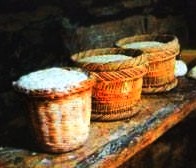There is little evidence, one way or the other, for Mabel Virginia Anna Hall-Dare (later Bent) being much of a cook. Born in 1847, into the comfortably-off, Anglo-Irish, minor aristocratic milieu, she dwelled as a girl in three wealthy and populated homes (Counties Meath, Sligo, and Wexford), including servants, before marrying the young, would-be explorer, Theodore Bent (later FSA, FRGS) in 1877. The couple then began a notable series of travels over the next twenty years to extensive regions of the Eastern Mediterranean, Africa and Arabia, in search of finds both archaeological and ethnographical.
The explorers travelled with fairly large amounts of gear, including of course cooking wherewithal, and, mostly, with an enterprising assistant from the isle of Anáfi in the Cyclades (a Cyclops’ stone’s through south-east of Santoríni), one of whose duties was to put food on the camp-table for the hungry couple, following days spent negotiating difficult terrain, assorted dangers, and looking for treasures. (Hospitality tantamount to religion in many of the lands they found themselves in, the Bents could also often rely on bed-and/or-board with eager-to-please hosts.)
These appetising adventures are all covered in Mabel’s travel diaries (her ‘Chronicles‘, published in three volumes by Archaeopress, Oxford), and the pages of the chronicler’s notebooks are peppered with reminiscences of what they had to eat – and the very occasional meals prepared by Mabel herself, when she had the inclination, time, or a special event in mind.
Thus, prior to publication in 2018 of ‘Mabel’s Menus’, selected tidbits of dishes from, inter alia, Greece, Turkey, Egypt, Ethiopia, Yemen, Iran, and Zimbabwe, will appear, που και που, on the Bent website blog (www.tambent.com) and Facebook. (Of course, if you would like to be notified when the book appears, do please contact info@tambent.com at any time.)
As a taster, Mabel would like to describe to you some meals they shared on Íos (23-25 January 1884) with their hosts, the family Lorenziades, descendants of whom still reside on the island today, and introduce you to one of her favourite cheeses:
“Breakfasted at a kafeneion and sent our letter up to the Demarch Lorenziades, who at once came down from the town and told us he had no rooms for us to sleep in but we were to feed with him. The baggage and I were put on mules and we went up to the Chora. The family consisted chiefly of the Demarch, who has a little common 2nd wife very inferior to the rest but a kind little thing. I should have thought it unnecessary to marry her when there are so many other women in the world; his elder brother and 3 very pretty jolly girls Marousa, Aikaterena and Kaleroe, all tall and fat. A 3rd brother is the schoolmaster. All were quite like gentlemen and all in black frock-coats. There were at least 6 more people.

“They received us most kindly and were really the most congenial people we have met. We took a house consisting of bedroom, pantry and sitting room, where Matthew [the Bents’ assistant, M. Símos] slept, and a kitchen, and went for our meals to the Demarch’s. They did everything they possibly could to please and amuse us. The dinner party consisted of the three brothers, the wife, Marousa and we 3. The first day we had chicken soup boiled, and roast chicken; 2nd ditto kid, 3rd ditto fish, and 3 times a day did we get mesithra and honey. Mesithra is a sort of curd made of sheep’s milk in a basket, just like ‘brocciu’ of Corsica. After dinner some of them dressed up in old costumes, of most splendid gold brocade and gold lace and embroidery. Such is the power of dress that we did not know where they had got the wonderfully beautiful woman in green and gold, and never found out till next day it was Aikaterene:
“Next morning, Friday [January] 25th, the Demarch came to fetch us to breakfast, and, M having evidently informed about the English customs, we had 2 eggs, a glass of milk and some mesithra and honey. Afterwards we and the Demarch started to Plaketos at the other side of the island: 3 hours. We saw the supposed tomb of Homer who died here on his way from Samos to Athens and then went to a little hut of an old man where we lunched in a very rough way; wine in a large wooden basin and scooped and drunk out of a little gourd. The hut was very low, door 4 feet high and a bed built of stones with twigs and straw 4 feet square. Even in better houses the doors are often too low. We had cold fish and cold soft eggs and they are hard, whether hot or cold, to eat without a spoon.” (from the Travel Chronicles of Mabel Bent, Vol 1, pp. 38-9)

A large amount of gear? At one point in 1890, if I recall, she recounts that they were a part of 16! That’s a pretty good-sized group to go up and down some of the rather slick and treacherous hillsides in the region where Mabel reports they carried her camera!